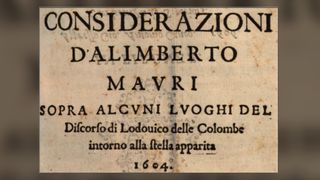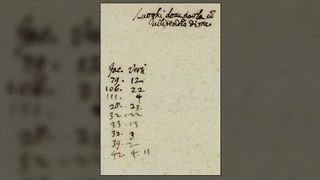Forged Galileo manuscript leads experts to controversial book he secretly wrote
A manuscript attributed to Galileo Galilei found to be a forgery in August has led to the discovery that a different, controversial book was authored by the celebrated Italian astronomer.

The revelation in August that a manuscript attributed to Galileo Galilei was a forgery has led to the discovery of a different book that the celebrated Italian astronomer actually did write, but under a pseudonym, a new investigation finds.
Previously unpublished notes by Galileo that were checked in the aftermath of the forgery's discovery indicate that he was the true author of a treatise titled the "Considerazioni Astronomiche di Alimberto Mauri" — Italian for the "Astronomical Considerations of Alimberto Mauri" — which was published in 1604.
Some other scholars at the time suspected Galileo was the author of the work when it was published, although it was attributed to the pseudonym Alimberto Mauri. At the time, writing under a pseudonym was a common practice to avoid controversy. Galileo is known to have published under other aliases, but his authorship of "Considerazioni Astronomiche" had not been confirmed until now.
"It's a full treatise, and it's written by one of the most brilliant minds of Western science," said Matteo Cosci, a researcher in the Department of Philosophy and Cultural Heritage at the Ca' Foscari University of Venice who made the latest discovery.

The treatise was published just a few years before Galileo's famous work "Sidereus Nuncius" (Italian for "Starry Messenger"), which in 1610 described his breakthrough observations of Earth's moon and four of Jupiter's moons through the first astronomical telescope on record.
"You may consider it as a prequel to 'Sidereus Nuncius,' which was the no-turning-back work that changed the history of astronomy and science in general," Cosci told Live Science. "For historians of philosophy like me, this is a treasure trove."
Sign up for the Live Science daily newsletter now
Get the world’s most fascinating discoveries delivered straight to your inbox.

Pseudonymous writing
The discovery that Galileo authored "Considerazioni Astronomiche" is tied to the finding earlier this year that a manuscript attributed to Galileo in the library of the University of Michigan was actually a forgery.
As Live Science reported, watermarks in the paper of the handwritten manuscript showed it must have been written more than 100 years after Galileo's death in 1642, making the document a fake. It was probably created by the prolific Italian forger Tobia Nicotra sometime in the 1920s or 1930s, an investigation by the university found; the manuscript was acquired at an auction in 1934 and was donated to the university in 1938.
The investigation also found that two letters used to authenticate the manuscript were also forgeries, again probably by Nicotra; and because one of the letters also asserted Galileo had written "Considerazioni Astronomiche," that attribution, too, was suspect.
Galileo never admitted to writing the "Considerazioni Astronomiche di Alimberto Mauri," and until now, the only evidence was the forged letter. But earlier this year, Cosci discovered an unpublished note authentically written by Galileo in a library in Florence, in which the astronomer listed several places where the Italian scholar Ludovico delle Colombe had attacked his ideas. Among these, Galileo noted that delle Colombe had criticized "Considerazioni Astronomiche di Alimberto Mauri" — showing that Galileo felt personally attacked whenever "Alimberto Mauri" was criticized in print, Cosci said.
"When Galileo wrote in his private note that '[Lodovico delle Colombe] speaks of me with contempt,' he was recognizing himself as Mauri," Cosci said.

Galileo's controversial theories
Cosci said delle Colombe had published a treatise arguing that the "new star" seen in 1604 (actually a supernova) was not new at all but rather permanent and only occasionally visible. Those ideas matched the prevailing Aristotelian theories embodied in Ptolemy's geocentric model of the solar system, which stated (incorrectly) that the sun, planets and stars were fixed and unchanging, and that they orbited the Earth.
Related: Why do the planets in the solar system orbit on the same plane?
But Galileo, writing pseudonymously as "Alimberto Mauri," proposed that the "new star" was actually new and suggested mechanisms that could have created it — a challenge to the Aristotelian view. He also introduced several other radical ideas for the time, such as that the moon might have mountains.
"It's safer to use a pseudonym, because if things don't fly right, then you don't get blamed," said Peter Barker, a professor of the history of science at the University of Oklahoma. "But if it does fly, you can then say, 'It was me all along.'"
Barker was not involved in the new discovery but said he's convinced by Cosci's research. The attribution of "Considerazioni Astronomiche" to Galileo has also been accepted by Nick Wilding, a historian at Georgia State University who detected the forgery of the University of Michigan manuscript.
"This is an excellent example of how patient and intelligent archival research can restore some of the damage inflicted by forgers," Wilding said in a statement. "Dr. Cosci has shown us that a combination of skepticism and skill will lead us to historical truth."
Cosci said Galileo wrote "Considerazioni Astronomiche" when he was teaching at the University of Padua, a northern Italian city that was then governed by the Republic of Venice. The treatise may have been an attempt by Galileo to find patronage in Rome, as it was dedicated to the Pope's treasurer, Cosci suggested.
But Rome and Venice were engaged in a diplomatic quarrel at that time, "so it would have been unwise of Galileo to place his name on a treatise that was dedicated to the public enemy," Cosci said.
Tom Metcalfe is a freelance journalist and regular Live Science contributor who is based in London in the United Kingdom. Tom writes mainly about science, space, archaeology, the Earth and the oceans. He has also written for the BBC, NBC News, National Geographic, Scientific American, Air & Space, and many others.
Most Popular


